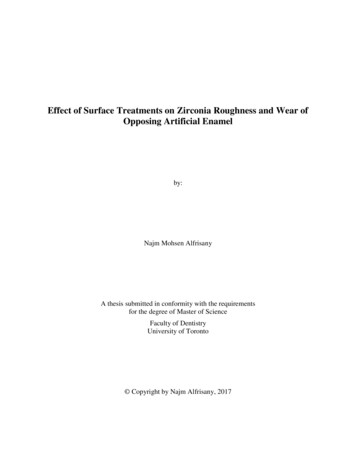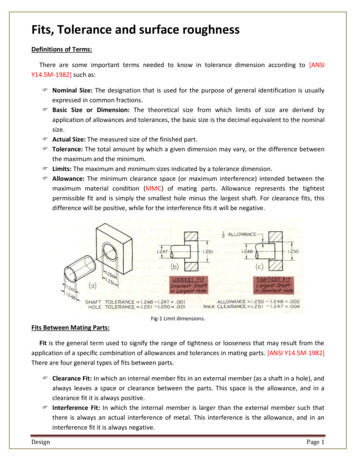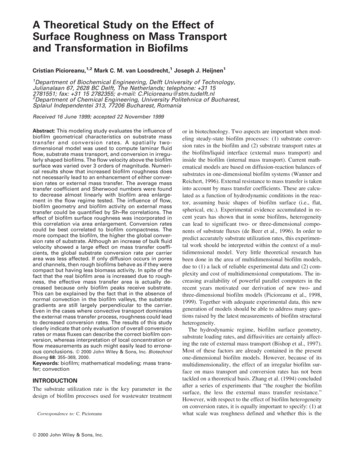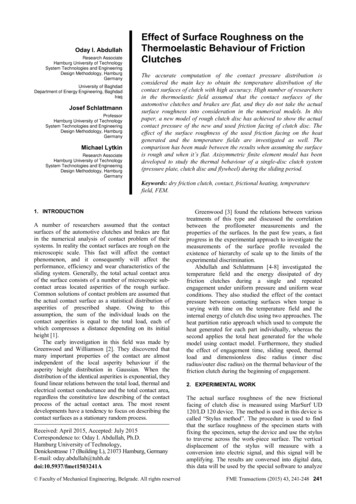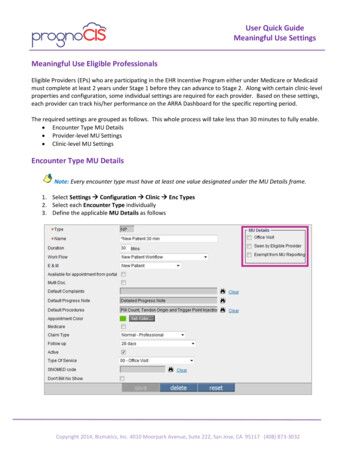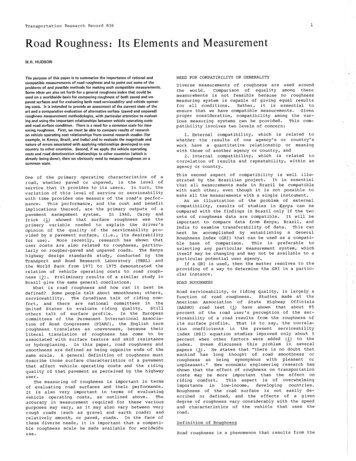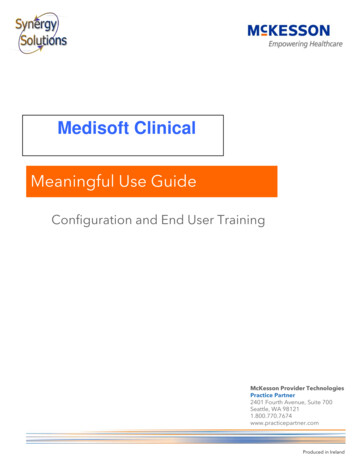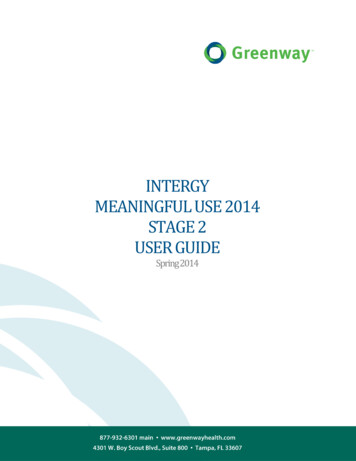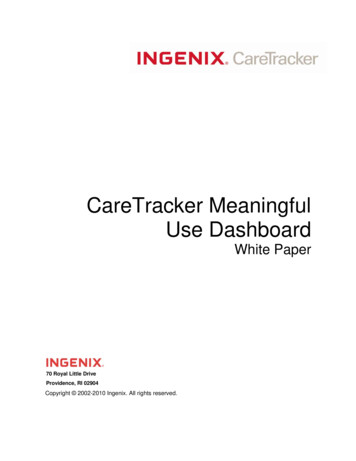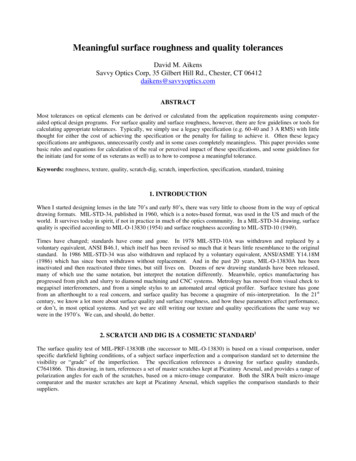
Transcription
Meaningful surface roughness and quality tolerancesDavid M. AikensSavvy Optics Corp, 35 Gilbert Hill Rd., Chester, CT 06412daikens@savvyoptics.comABSTRACTMost tolerances on optical elements can be derived or calculated from the application requirements using computeraided optical design programs. For surface quality and surface roughness, however, there are few guidelines or tools forcalculating appropriate tolerances. Typically, we simply use a legacy specification (e.g. 60-40 and 3 A RMS) with littlethought for either the cost of achieving the specification or the penalty for failing to achieve it. Often these legacyspecifications are ambiguous, unnecessarily costly and in some cases completely meaningless. This paper provides somebasic rules and equations for calculation of the real or perceived impact of these specifications, and some guidelines forthe initiate (and for some of us veterans as well) as to how to compose a meaningful tolerance.Keywords: roughness, texture, quality, scratch-dig, scratch, imperfection, specification, standard, training1. INTRODUCTIONWhen I started designing lenses in the late 70’s and early 80’s, there was very little to choose from in the way of opticaldrawing formats. MIL-STD-34, published in 1960, which is a notes-based format, was used in the US and much of theworld. It survives today in spirit, if not in practice in much of the optics community. In a MIL-STD-34 drawing, surfacequality is specified according to MIL-O-13830 (1954) and surface roughness according to MIL-STD-10 (1949).Times have changed; standards have come and gone. In 1978 MIL-STD-10A was withdrawn and replaced by avoluntary equivalent, ANSI B46.1, which itself has been revised so much that it bears little resemblance to the originalstandard. In 1986 MIL-STD-34 was also withdrawn and replaced by a voluntary equivalent, ANSI/ASME Y14.18M(1986) which has since been withdrawn without replacement. And in the past 20 years, MIL-O-13830A has beeninactivated and then reactivated three times, but still lives on. Dozens of new drawing standards have been released,many of which use the same notation, but interpret the notation differently. Meanwhile, optics manufacturing hasprogressed from pitch and slurry to diamond machining and CNC systems. Metrology has moved from visual check tomegapixel interferometers, and from a simple stylus to an automated areal optical profiler. Surface texture has gonefrom an afterthought to a real concern, and surface quality has become a quagmire of mis-interpretation. In the 21stcentury, we know a lot more about surface quality and surface roughness, and how these parameters affect performance,or don’t, in most optical systems. And yet we are still writing our texture and quality specifications the same way wewere in the 1970’s. We can, and should, do better.2. SCRATCH AND DIG IS A COSMETIC STANDARD1The surface quality test of MIL-PRF-13830B (the successor to MIL-O-13830) is based on a visual comparison, underspecific darkfield lighting conditions, of a subject surface imperfection and a comparison standard set to determine thevisibility or “grade” of the imperfection. The specification references a drawing for surface quality standards,C7641866. This drawing, in turn, references a set of master scratches kept at Picatinny Arsenal, and provides a range ofpolarization angles for each of the scratches, based on a micro-image comparator. Both the SIRA built micro-imagecomparator and the master scratches are kept at Picatinny Arsenal, which supplies the comparison standards to theirsuppliers.
This approach to surface imperfections was first proposed by McLeod and Sherwood in 19452. They offered upcomparison standards numbered from 10 to 120, to be used in this comparison method. As early as 1945 they recordedthat “there is little correlation between the appearance or visibility of a scratch and its measured width.” FrankfordArsenal documents dating to the same period declare that “these numbers are arbitrary, and are not to be assumed asdenoting the width of the scratch.” Scratch morphology is a better predictor of scratch visibility or brightness, thanwidth3. Since the purpose of the scratch and dig standard is to control cosmetic imperfections, and the primary criterionof a cosmetic imperfection is its visibility, this is a perfectly reasonable approach, and continues to be used by the USArmed Services to this day. While dig comparison sets, based on a particular size and shape, are relatively easy tomanufacture and calibrate, the scratch visibility standard is highly subjective. The master scratch set consists of a set offive pairs of scratched pieces of glass. Each set corresponds to one scratch number, and represents the miminum andmaximum visibility for the comparison standards, under the illumination conditions established by MIL-PRF-13830B.These scratches are the master set from Frankford Arsenal, and are still being used to certify sub-master comparisonstandard sets which are sent to the field to be used in inspections. Today, they are at Picatinny Arsenal in New Jersey,and have remained more or less intact and virtually unchanged in 50 years.In the 1970’s, though, a series of enigmatic revisions were made, not to the MIL specification, but to thedrawing C7641866, which has created an enormous amount of confusion in our industry. In 1974, revision H of thedrawing specified a comparison set wherein the scratch number was to be the width of the scratch in microns. To makematters worse, in 1976 revision J described a comparison set wherein the scratch number was the width of the scratch intenths of microns. Finally in 1980, revision L made all such width notes for reference only, although in fact the scratchwidths are meaningless; scratch width and visibility are uncorrelated. In all this time, the limit masters and the meaningof, say, a #60 scratch, remained unchanged. As a result of these unfortunate revisions, however, there have been manymyths and legends in our industry regarding the scratch standard. But the simple truth about the scratch standard is that:1) The scratch-dig standard is, and has always been, a visibility standard, not a width standard.2) The scratch number is not the width in microns or tenths of microns.3) The Army never tightened the scratch specification by 10x.4) Scratch standards do not “heal” over time. (They do, however, get dirty and need to be cleaned.)Because of this series of unfortunate events4, however, and the desire of the industry to have an objective, rather thansubjective surface quality standard, the scratch and dig standard has become the most mis-used, ambiguous, and misinterpreted specification in our industry5. Most of these problems can be sorted out, however, by changing the way wecall out our surface quality specification.3. MEANINGFUL SURFACE QUALITY SPECIFICATIONS - COSMETICIf you are trying to specify the cosmetic quality of your optics, then the scratch-dig number system still works for you.The trick is to specify a scratch and dig that fits your application. Most people are not actually familiar with thevisibility of the scratches in the scratch-dig standard. Table 1 is a qualitative assessment of scratch visibility by number 6,and the most common scratch-dig pair for a given level of desired visibility.Table 1. Scratch visibility by number, and some common applicationsScratchnumber1020406080Scratch visibility undernormal viewing conditionsVery, very hard to seeBarely visibleAlmost the same as the #20Typicalcallout10-520-1040-20Somewhat visibleEasy to see60-4080-50ApplicationNot recommended; see belowNot recommended; see belowClose to image plane, ordark-field illuminationPrecision OpticsCommercial Optics
I don’t recommend using anything tighter than 40-20, and for most applications 60-40 is more than adequate. Eventhough the #40 scratch is barely visible in normal conditions, there are cases where the lens will be used with significantmagnification, or where the surface will be illuminated by a bright light and viewed in dark-field, and the cost of a 40-20specification is justified. But if your application is sensitive enough to surface imperfections to specify anything tighter,then you are using the wrong standard. More on that in Section 4, below.For cosmetic applications, though, rather than use the MIL-PRF-13830B, it is wiser and safer to use the voluntaryequivalent, ANSI/OEOSC OP1.0027. This new standard is still being maintained, is less ambiguous, is not at risk ofbeing withdrawn, and has far less confusion associated with it than the MIL standard. Since it uses the same comparisonstandards as the MIL, the meaning of the numbers is the same. The language to invoke this standard is “Surface quality60-40 per ANSI/OEOSC OP1.002.” You will want to also specify the comparison standard to be used.Discounting the ones claiming to offer width-based standards (which is just plain wrong) and chrome on glass reticles(which don’t look like scratches, IMHO), there are three commercial manufacturers of comparison standards;FLIR/Brysen, Davidson Optronics, and Jenoptik. This last is the plastic paddle sold by both Edmund Optics and ThorLabs. I’m not sure how repeatable any of these standards are, but I suspect each company does a decent job of certifyingthem to whatever internal masters they have. Remember though, that only Picatinny Arsenal has the SIRA tool or thelimit masters, so all claims to make standards to C7641866 should be taken with a grain of salt. In some cases, these setsare not mutually compatible. The #10 artifact of one brand could be brighter than the #60 artifact of another8. So themeaning of the visibility of a scratch is dependent on the comparison samples being used. For all commercialprocurements, the brand of the comparison standard should be referenced on the drawing. For example, “Surface quality80-50 per ANSI/OEOSC OP1.002 using brand x comparison standard,” is a reasonably unambiguous approach to acosmetic surface quality requirement.One word of caution; adding a complex dielectric or metal coating to a substrate can change or amplify the visibility ofany given scratch or dig. I have seen cases where substrates that passed a 40-20 spec just fine couldn’t pass a 60-40 specafter coating.4. MEANINGFUL SURFACE QUALITY SPECIFICATIONS - DIMENSIONALSome applications require a width specification, or are sensitive to scratches too small to see. In 1985, there were nopractical alternatives to scratch and dig in the US. Lots of people have tried to extend the usefulness of the scratch-digstandard by adding higher brightness light sources and magnification, which has caused more confusion. In 1996, withthe publication of ISO 10110, there was an alternative. Based on the German DIN 3140 standard, part 7 describes allsurface imperfections in terms of a “root area”, and not only allows but practically requires direct measurement of everyscratch and dig. Lately this approach has been gaining momentum, but aside from a few stalwarts, it has not becomecommon practice in the US.Even when using this international standard, some careful attention is required. Although the notation is clear andunambiguous, a strict interpretation of the standard requires microscopic inspection and documentation of every surfaceimperfection greater than 0.16x the size of the maximum allowed imperfection. This kind of inspection can be muchmore expensive than the optic being inspected, and is usually far more than the engineer had really wanted.The newest revision of the American National Standard for surface imperfections, OP1.002, retains the visibility methodfrom MIL-PRF-13830B discussed in Section 3, but adds the dimensional method from MIL-C-48497A, which isfamiliar, easy to use, and effective for people who really require a functional specification. To invoke the dimensionalmethod, a pair of letters is used, such as A-A or E-E, to reference a specific size of imperfections. This new notation isgathering a following in the United States, especially in applications which demand very tight tolerances on surfaceimperfections, such as in micro-optics or objectives, CCD cover glass, reticles, and high energy laser applications, or onapplications which are tolerant of large surface imperfections but are on reflective or partially reflective optics like IRimaging. Thanks to the specification of a precise dimension, the standard is objective, but because grades are used,
visual inspection for most optics is sufficient. On marginally acceptable optics with fairly tight specifications,microscopic inspection and documentation is still required to determine if the part passes the accumulation specification.Table 2 shows the translation from a given scratch width and dig diameter specification to the correct specifications perOP1.002. For grades that are not in the table, a new notation is provided. Any size surface imperfection can be specifiedusing the letter “A” followed by a number. The number indicates the maximum size imperfection in microns. That is, aspecification A2-A20 has a maximum allowed scratch width of 2 micron and a maximum dig diameter of 20 micron. Ifsuch a non-standard specification is required, some thought should be given to how the supplier is expected to inspectand measure such imperfections. Providing even minimal guidance on the drawing such as “Inspect with 40x stereomicroscope and 150 Watt tungsten halogen fiber light source” can go a long way to eliminating unnecessary confusionand cost.Table 2. Translating scratch width and dig diameter to correct specifications per OP1.002.Maximumscratch widthin EDCBAAnMaximumdig diameterin GFEDCBAAnAlternatively, a surface quality specification can be derived based on total scattered light. Care must be taken to estimatethe worst possible scenario for accumulation, and assumptions must be made regardin
In 1986 MIL-STD-34 was also withdrawn and replaced by a voluntary equivalent, ANSI/ASME Y14.18M (1986) which has since been withdrawn without replacement. And in the past 20 years, MIL-O-13830A has been inactivated and then reactivated three times, but still lives on. Dozens of new drawing standards have been released, many of which use the same notation, but interpret the notation differently .
